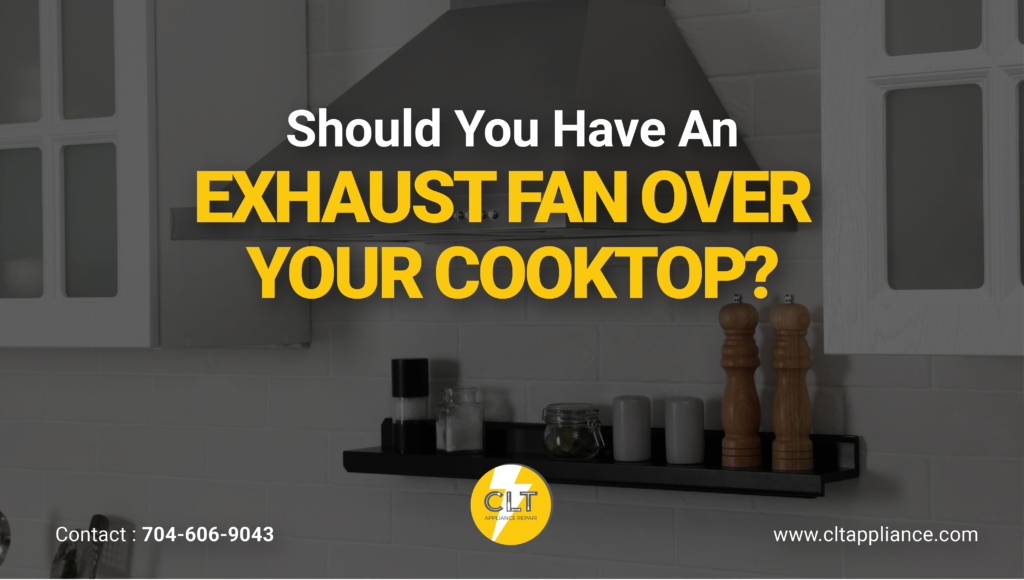The kitchen is the place where flavors find their embodiment, where one congregates with family members, and where wonderful memories are made. But the cooktop in the house actually has some influence on the house’s air. Steam, smoke, and fumes combined are usually released into the air. In no time, the kitchen will feel stuffy, making the entire house uncomfortable.
With proper ventilation through an exhaust fan over your cooktop, the air in your kitchen will be purified by sucking in harmful pollutants, moisture, and odors. Indeed, very few homeowners bother to check this simple addition in the kitchen or do not know the criteria for choosing such appliances.
Is a kitchen exhaust fan beyond the cooktop really necessary for your cooking arrangement? Presently, such queries can get over dramatic with countless cooktops and exhaust systems available. The truth is that you get several advantages from installing a cooktop featuring an exhaust fan if you’re cooking on a gas cooktop with an exhaust fan or even an induction cooktop with an exhaust fan. But what exactly makes an exhaust fan so important, and how do you know what type of system will suit your kitchen needs? Well, let us have a sneak peek into the answers you want!
Should I Have an Exhaust Fan Over My Cooktop?
YES, you should absolutely have an exhaust fan over your cooktop, and let me tell you why: proper ventilation is essential to keep your kitchen comfortable, safe, and healthy.
Cooking produces byproducts into the air, all of which don’t do anything good for maintaining favorable atmospheric conditions in the kitchen. It also produces heat along with other byproducts, including even the toxic gases of CO and NO2. These substances make the kitchen air rather unpleasant, along with unwelcome odors, and risk human health.
Installation of an exhaust fan above the cooktop can eliminate the aforementioned risks by taking out all the harmful materials from the air, thereby increasing air quality and preventing excess moisture from occurring, which usually creates conditions for mold and mildew to grow.
What is the Role of Exhaust Fans in Your Kitchen?
Every time you cook, your cooktop releases a mix of steam, heat, and fumes upward. Without proper ventilation, these byproducts have nowhere to go but into your kitchen air. Let’s learn why a cooktop with an exhaust fan isn’t just nice to have, it’s essential for your kitchen’s health.
1. Air Quality Protection
Your exhaust fan is your first line of defense against cooking pollutants. Research shows running your fan at high speed reduces exposure to cooking pollutants by 80%. This is especially important if you have a gas cooktop with a built-in exhaust fan, as gas cooking produces more pollutants than electric.
- Removes toxic carbon monoxide and nitrogen dioxide (especially important for gas cooktops)
- Captures fine particulate matter that can harm your lungs
- Eliminates volatile organic compounds released from heated oils
- Clears airborne grease particles before they settle
- Removes steam and water vapor that can damage your kitchen
- Gets rid of lingering food odors and smoke
- Filters out burning residues from high-heat cooking
2. Temperature Management
Nobody likes cooking in a hot, stuffy kitchen. The right height of the exhaust fan over the cooktop makes all the difference in keeping your space comfortable.
- Pulls away excess heat from your cooking surface
- Stops heat from damaging your upper cabinets
- Keeps your kitchen temperature comfortable
- Reduces the workload on your air conditioning
- The optimal height of the exhaust fan over the cooktop should be 24-30 inches
- Needs 250 CFM airflow for wall-mounted standard ranges
- Requires 375 CFM airflow for island installations
3. Moisture Prevention
Water damage starts small but can cost big. If you have a cooktop with a built in exhaust fan, controlling moisture must be your top priority.
- Protects cabinet bottoms from steam damage
- Prevents condensation on walls and windows
- Keeps countertop seams dry and sealed
- Protects backsplash grout from excess moisture
- Stops paint from peeling due to humidity
- Prevents expensive mold and mildew growth
- Protects your cabinets from warping
4. Grease Control
Every cooktop with an exhaust fan system needs to handle grease differently. Gas cooktops typically produce more particulate matter, while electric cooktops with exhaust fans might need less intensive filtration.
- Captures grease from frying and searing
- Protects your upper cabinets from sticky residue
- Keeps ceiling surfaces clean and grease-free
- Protects light fixtures from grease buildup
- Prevents wall discoloration
- Keeps decorative elements pristine
- Handles extra particulate matter from gas stoves
4 Different Types of Exhaust Fans for Your Cooktop
Exhaust fans come in various styles and designs, depending on the setup of your kitchen and your personal preferences. Here are some common options:
-
Ducted Range Hoods
These systems vent air directly outside of the house, making them one of the most efficient ways to keep the kitchen fresh. While typically requiring ductwork and is usually more expensive for the installation, nothing can compete with ducted range hoods concerning efficiency in taking smoke, grease, and heat out of the house.
A gas cooktop with an exhaust fan system, for example, is very effective with a ducted range hood because it helps remove away the larger amounts of carbon monoxide and nitrogen dioxide generated.
-
Ductless Range Hoods
Ductless range hoods are not as effective as ducted systems but are easier to install and cheaper overall. These fans filter air through a charcoal or carbon filter and recirculate it back into the kitchen.
Electric cooktops with exhaust fan can benefit from ductless fans, especially in small kitchens, where installation of ductwork would not be feasible.
-
Over-the-Range Microwaves
We have some modern cooktops that are associated with an exhaust fan for usage and come as built-in microwaves, thus summing up all the two-in-one appliances. As much as these are space-saving, such systems lack strong efficiency as compared to dedicated range hoods concerning ventilation.
-
Cooktop with Built-In Exhaust Fan
If you have quite a limited space or a minimalistic kitchen setup, you might want to consider a cooktop with a built-in exhaust fan. These systems can be directly integrated into the cooktop and provide convenience and efficiency. It can come in handy especially with kitchens having an island or any other open layout.
Smart Usage Tips for Exhaust Fans in Kitchens
Here’s a shocking stat: only 12% of households always use their range hood, while 28% never use it at all. Whichever cooktop model you have, these tips can help avoid buying cooktop repair Charlotte NC services:
- Turn on your fan 5 minutes before cooking
- Open a window slightly for better airflow
- Use higher speeds when cooking at high heat
- Keep pots centered under the hood
- Run the fan for 15 minutes after cooking
- Clean your filters regularly
- Wipe visible condensation promptly
A properly installed cooktop with an exhaust fan can capture cooking emissions. That’s a lot of protection for your kitchen and your health. Make it a habit to use your fan every time you cook. Your kitchen (and your lungs) will thank you!
Key Considerations When Installing an Exhaust Fan Over Your Cooktop
When choosing the proper exhaust fan for the cooktop, many things should always be taken into account.
- Local Building Codes: Some places have special provisions for the kitchens to have specific ventilation. So, before installing exhaust ducts over the cooktop, be sure to comply with some local building codes.
- Size and Layout of Your Kitchen: A large kitchen might require a powerful exhaust system as part of keeping air quality up, while a small kitchen might excellently be served with a less powerful and more compact system.
- Type of Cooktop: Lastly, the type of cooktop often affects what kind of ventilation system you will be getting. For example, gas cooktops need higher ventilation because they produce more pollutants than induction cooktops with exhaust fans, which normally need less power as they produce fewer fumes.
Bottom Line
Choosing the right exhaust fan depends on your cooktop type, kitchen size, and ventilation needs. Proper installation and maintenance are key to maximizing its effectiveness. If you’ve been questioning whether you really need an exhaust fan, the answer is simple: Yes, it makes a significant difference for both your health and your kitchen’s overall atmosphere. So, if your kitchen lacks a proper ventilation system or if it’s time for an upgrade, investing in a cooktop with an exhaust fan is a smart move for any home.
Is your exhaust fan not performing at its best? Or perhaps you’re considering upgrading your kitchen ventilation system? At CLT Appliance Repair, we’re trusted experts in kitchen ventilation and cooktop repair Charlotte NC care.
Book a ventilation system inspection today and we’ll ensure your kitchen’s exhaust system is working at peak efficiency, protecting your home and family!
FAQs
- Why is an exhaust fan important over a cooktop?
An exhaust fan removes smoke, heat, steam, and harmful pollutants from the air, which improves kitchen air quality and makes the cooking environment more comfortable.
- What is the ideal height of the exhaust fan over the cooktop?
The ideal height for an exhaust fan over a cooktop is between 24 to 30 inches, which provides optimal ventilation without overwhelming the space.
- Can I install an exhaust fan over a gas cooktop?
Yes, an exhaust fan over a cooktop is highly recommended for gas cooktops due to the increased production of pollutants like carbon monoxide and nitrogen dioxide.
- What are the benefits of a gas cooktop with a built-in exhaust fan?
A gas cooktop with a built-in exhaust fan offers several advantages. This integrated system helps to immediately remove smoke, fumes, and pollutants created during cooking, improving the air quality in your kitchen.
Author

- John Bennett
- John Bennett is a seasoned appliance repair specialist at CLT Appliance Repair, where he brings over a decade of technical expertise and a strong commitment to customer satisfaction. With a background in electrical and mechanical systems, John has built a reputation for reliable, efficient, and honest repair services across a wide range of household appliances-including refrigerators, washing machines, ovens, and more.







